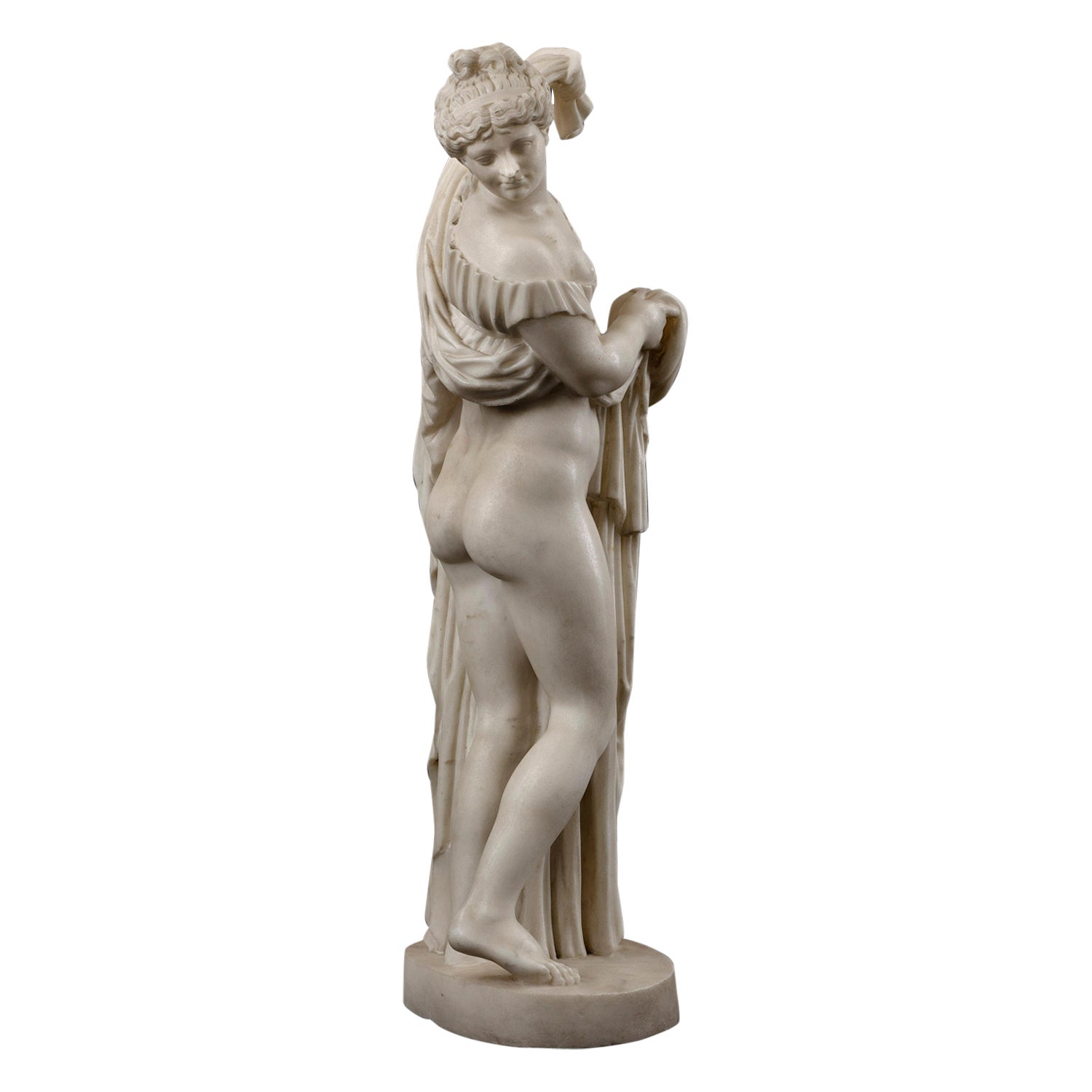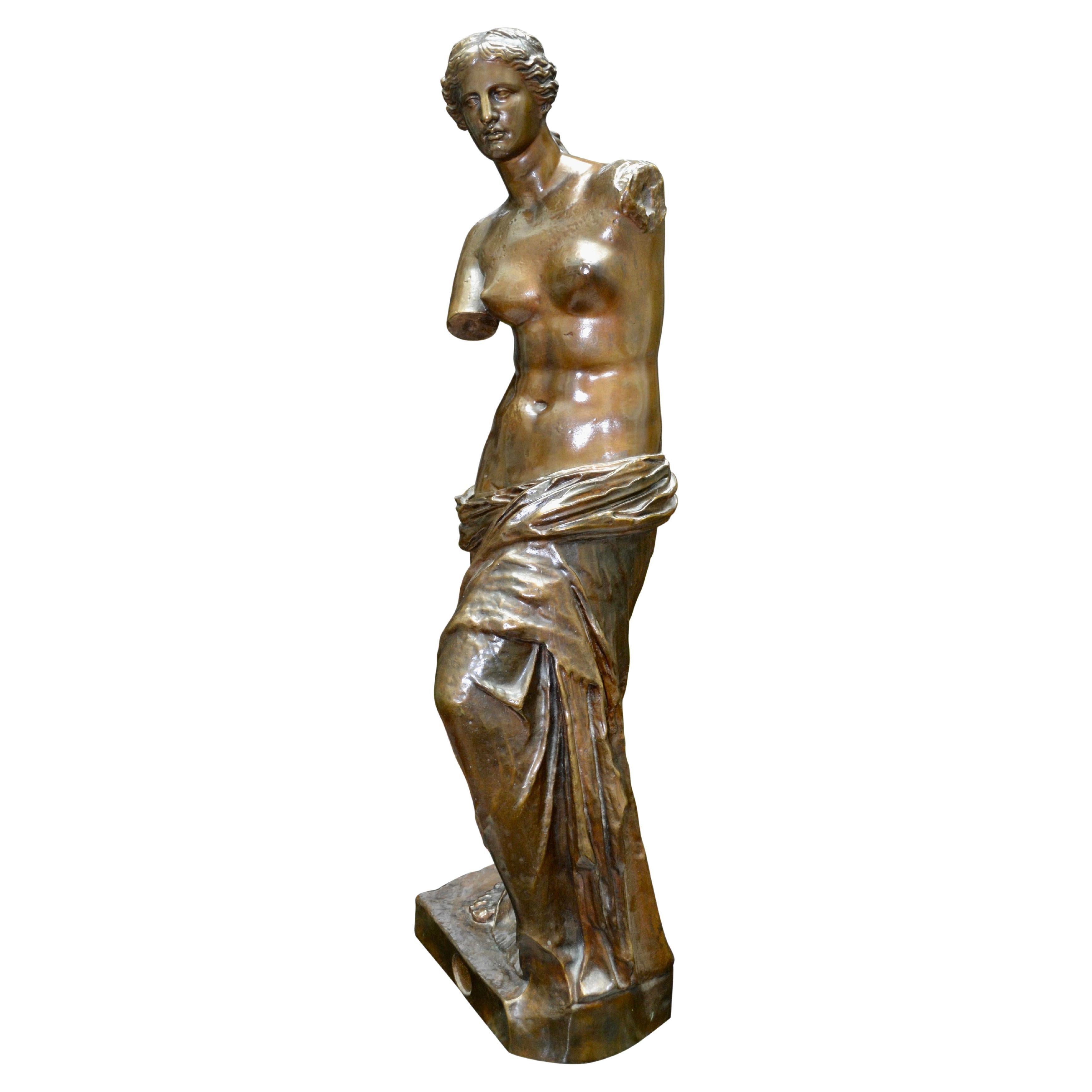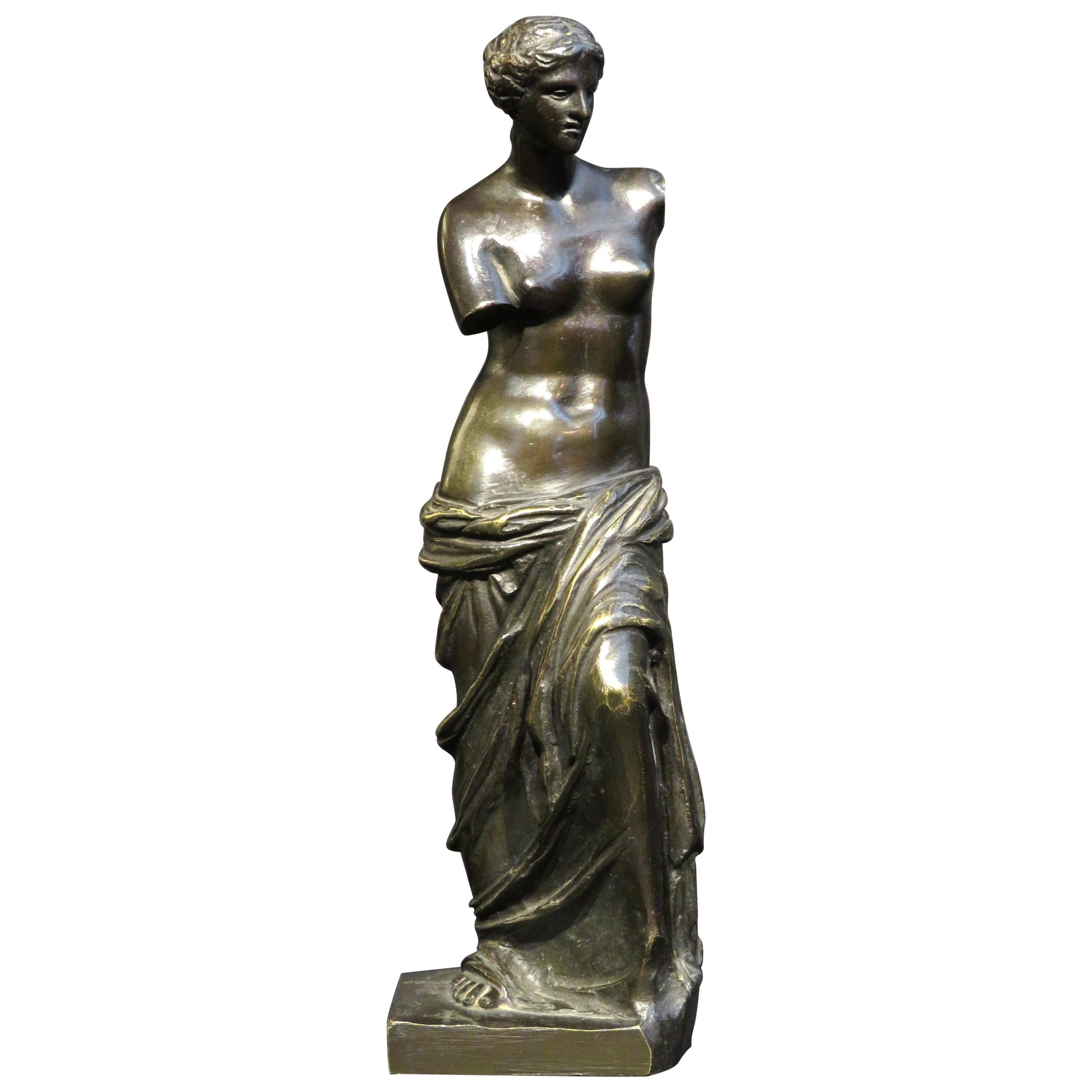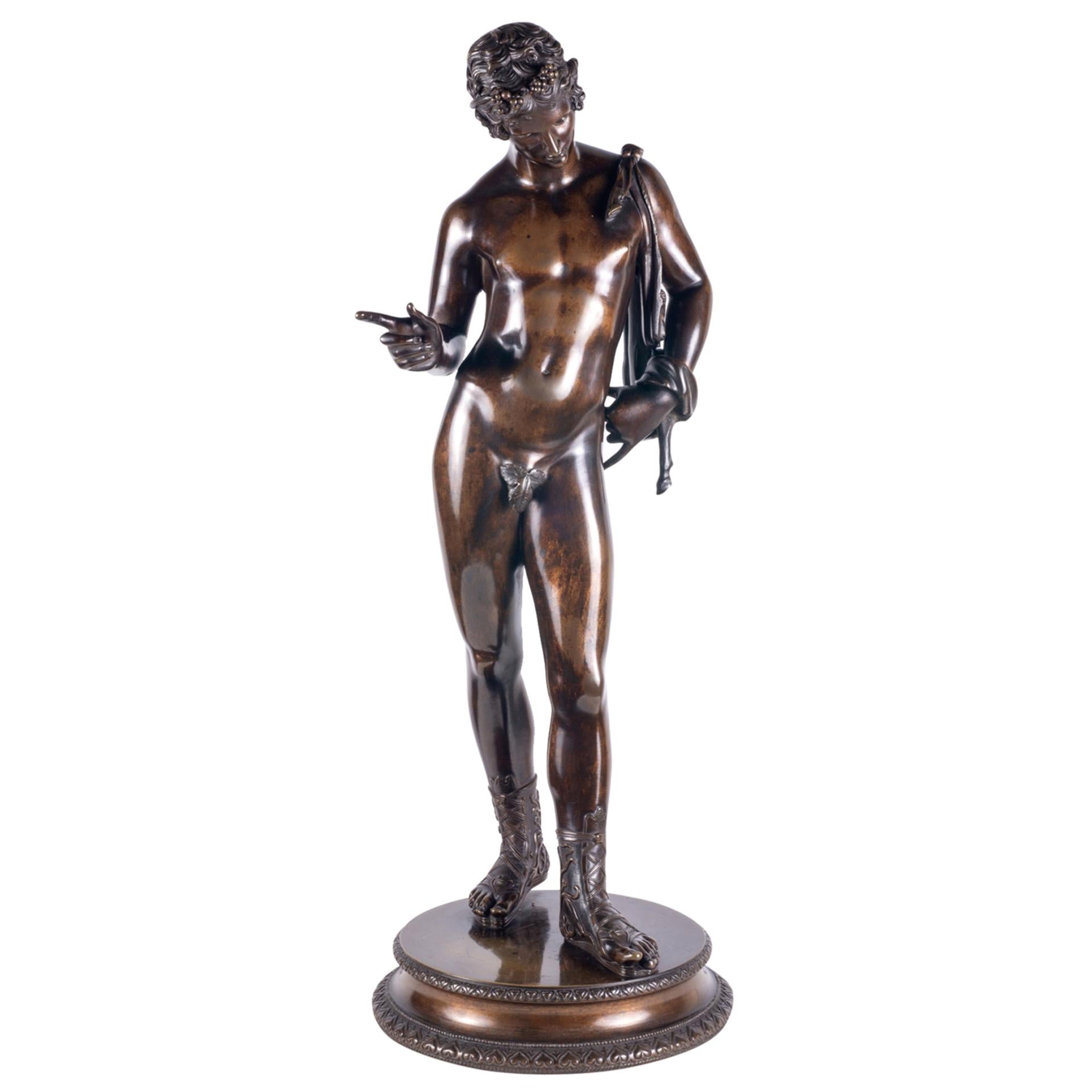Items Similar to 19th Century Grand Tour Bronze Sculpture “Callipygian Venus” of Antiquity
Want more images or videos?
Request additional images or videos from the seller
19th Century Grand Tour Bronze Sculpture “Callipygian Venus” of Antiquity
About the Item
GRAND TOUR MODEL AFTER ANTIQUITY
Naples, Italy (19th Century)
"The Callipygian Venus"
Sand-cast and patinated bronze signed foundry mark in the base "Fonderia Artistica Sommer Napoli" (active by 1885-1916) cast late 19th century
Item # 402KRG29Z
A beautifully cast Grand Tour reduction of the Callipygian Venus after the life-size statue of antiquity, the sculpture was executed by the boutique foundry established by Giorgio Sommer (German/Italian, 1834-1914) for the casting of sculpture in bronze and later the carving of sculpture in marble. Giorgio Sommer was a German photographer who spent most of his career in Italy, moving to Naples in 1857 where he first established his photography business. At some point thereafter he opened the foundry, which was rather successful, likely due to the very fine quality of output the firm produced. While most records show the foundry opened in 1885, sources suggest they were producing sculpture early in the 1870s before exhibiting in 1885. Thereafter they produced illustrated cataloges of their sculpture for marketing and distribution. He died in 1914 and the foundry survived him only two years before closing its doors in 1916.
The present example is a richly detailed model with extensive carving and articulation of the underlying model; note the rich stylus work in Venus's hair, the handiwork apparent in the repeating motif around the base and the raised signature of the foundry, which is captured directly from the mold and not simply cold-tooled onto the base. The surface throughout is characterized by perfection: smooth and exquisitely finished garments and skin all finished in a medium-brown translucent patina.
The model depicts the Callipygian Venus, also known as the Venus Kallipygos or the Aphrodite Kallipygos. The term "Callipygian" is derived from the Greek words "kallos" meaning beautiful, and "pyge" meaning buttocks.
The original is an ancient Roman marble statue, itself a copy of an earlier Greek statue from the Hellenistic era. The sculpture depicts Venus (or Aphrodite in Greek mythology) looking back and lifting her drapery to reveal her lower back and buttocks. This subject was popular among tourists on the Grand Tour during the 18th and 19th centuries. Travelers would commission or purchase such artworks as mementos that reflected the cultural heritage they encountered on their journeys throughout Europe, especially in Italy.
Such sculptures were admired not only for their aesthetic appeal but also for their cultural and historical significance, embodying the Neoclassical appreciation for the art and mythology of antiquity that was prevalent during the Grand Tour period.
Literature:
An excellent discussion on Fonderia Sommer can be found at Art UK rooted in original source material. Click here to read more on the foundry and Giorgio Sommer's photography.
Measurements: 25 1/2" H x 9 7/8" base diameter
Condition Report:
Trace wear to patina throughout; ever so slight inward curve to the base, perhaps being cast slightly too thin to properly support the weight of Venus in the center. Carefully cleaned and sealed in conservator's grade wax.
About silla antiques & art
Established in 2009, we have available in our 9000 square foot brick-and-mortar gallery an ever-changing selection of carefully curated and catalogued furniture, decorative arts, paintings, sculpture and estate jewelry. Our company has long specialized in sculpture circa 1860 through 1930 and as such the gallery always has a very large collection of exceptional European and American sculpture available on display.
The gallery is located at 117 W Burd Street in Shippensburg, Pennsylvania and is open by appointment only. We welcome your visit and would love to meet with you at the shop. For clients located outside of the area, we are always available to discuss items by video conferencing or by phone.
- Dimensions:Height: 25.5 in (64.77 cm)Width: 9.88 in (25.1 cm)Depth: 9.88 in (25.1 cm)
- Style:Grand Tour (Of the Period)
- Materials and Techniques:
- Place of Origin:
- Period:
- Date of Manufacture:Unknown
- Condition:Trace wear to patina throughout; ever so slight inward curve to the base, perhaps being cast slightly too thin to properly support the weight of Venus in the center. Carefully cleaned and sealed in conservator's grade wax.
- Seller Location:Shippensburg, PA
- Reference Number:
About the Seller
4.9
Recognized Seller
These prestigious sellers are industry leaders and represent the highest echelon for item quality and design.
Platinum Seller
These expertly vetted sellers are 1stDibs' most experienced sellers and are rated highest by our customers.
Established in 2009
1stDibs seller since 2014
472 sales on 1stDibs
Typical response time: <1 hour
- ShippingRetrieving quote...Ships From: Shippensburg, PA
- Return PolicyA return for this item may be initiated within 14 days of delivery.
More From This SellerView All
- Italian Grand Tour Antique Bronze Sculpture, Bust of Julius CaesarLocated in Shippensburg, PAGRAND TOUR Italian, 19th century Bust of Julius Caesar Patinated and pigmented sand-cast bronze over Violet Breche marble socle unsigned Item # 212WHZ09P A finely cast and beau...Category
Antique 19th Century Italian Grand Tour Busts
MaterialsMarble, Bronze
- Pair of Grand Tour Bronze Busts, “Homer” & “Pseudo-Seneca”, circa 1880By Chiurazzi fondataLocated in Shippensburg, PAGRAND TOUR Italian School Pair of Busts, "Homer" & "Pseudo-Seneca", after Antiquity Patinated bronze mounted on solid marble plinths cast by Chiurazzi, Naples circa 1880 each sealed with foundry cachet on shoulder Item # 304KUV24Y A rare and exciting pair of Grand Tour busts after Antiquity, each is executed in bronze and finished in a Herculaneum black patina with hints of verde in the underlying surface by the foundry of J. Chiurazzi of Naples. Foundry seals are located on their shoulders verso. The first is a fine cast of Homer after the marble bust of Antiquity formerly in the Farnese collection and currently in the permanent collection of the National Archaeological Museum of Naples. It depicts the aged Greek poet and author of the Illiad and the Odyssey as a bearded man dressed in a tunic with a ribbon holding back his hair while concerned wrinkles line his forehead. His eyes are empty and devoid of anything, the absence alluding to his blindness while the sheer intensity of his spirit overwhelms the viewer. His simple garment are a reminder of his poverty. The second bust known as "Pseudo Seneca" is cast after the original bust of antiquity found in 1754 at Herculaneum in the Villa of the Papyri, the home of Lucius Calpurnius Piso Caesoninus, father-in-law of Julius Caesar. The estate was buried in the eruption of Mount Vesuvius. The bust had been thought to be an image of Lucius Annaeus Seneca - Seneca the Younger - the famous Stoic philosopher and fabulously wealthy advisor to Nero. However, after a titled bust of Seneca...Category
Antique 19th Century Italian Grand Tour Busts
MaterialsMarble, Bronze
- French Bronze Sculpture Antique Bust of Greek Warrior, late 19th centuryLocated in Shippensburg, PAFRENCH SCHOOL 4th qtr, 19th century Bust of Greek Warrior Patinated bronze unsigned cast circa late 19th century Item # 304KEX30P A fine ca...Category
Antique 19th Century French Romantic Busts
MaterialsBronze
- 19th Century Carrara Marble Bust Sculpture of Classical StatesmanLocated in Shippensburg, PAA CARVED MARBLE BUST OF A CLASSICAL STATESMAN Carrara marble on separately turned socle unsigned Circa mid-to-late 19th century Item # 307FDI13Q An incredibly powerful bust of ...Category
Antique 19th Century Victorian Busts
MaterialsMarble
- "Two Fates" German Bronze Sculpture after the Antique Cast by R. BellairLocated in Shippensburg, PAGRAND TOUR POLYCHROMED BRONZE GROUP OF "TWO FATES" Foundry cachet verso for "R. Bellair & Co, Berlin, Friedrichstr.182" Item # 012JIP09L A good Grand Tour classical bronze group bas...Category
20th Century German Grand Tour Figurative Sculptures
MaterialsBronze
- French Antique Bronze Sculpture of "Harvester" by Mathurin MoreauBy Mathurin MoreauLocated in Shippensburg, PA"HARVESTER" AFTER A MODEL BY MATHURIN MOREAU (FRENCH, 1822-1912) In a reddish-brown and golden patinated bronze; signed in base "Math. Moreau" Item # 012SKP14W A fine model of a rural young farmer resting against a rocky outcrop to sharpen his scythe, the base of which has been set in the hay collected in a pile beside the rock; the naturalistic base is signed along the back in his typical nearly cursive script "Math. Moreau". It is a complex model and a fine accomplishment for the foundry, the joints seamlessly flowing into one another without any obvious connections. The surface is chiseled with great care, resulting in fine detailing of the toes and fingers to include the wrinkles at each joint and texturing of the nails, crisp eyelids and flawless skin, gorgeous texturing of the garment...Category
Antique Early 1900s French Romantic Figurative Sculptures
MaterialsBronze
You May Also Like
- Late 19th Century Grand Tour Italian Bronze Sculpture of Nude Venus CandlestickLocated in Lisse, NLElegant and highly stylish candlestick or table lamp. This handcrafted and heavy quality, bronze candle stick or table lamp from the 1890-1910 era is in very good condition. This ro...Category
Antique Late 19th Century Italian Grand Tour Table Lamps
MaterialsBronze
- Callipygian Venus - Italian, 19th CenturyLocated in Bruxelles, BECallipygian Venus 19th Century Italian (Naples or Rome) White marble After the Antique: Naples Archaeological Museum (IT) Roman version of a Hellenistic 3rd Century B.C. model Height: 62 cm Width: 22 cm H 24 1/2 x W 8 2/3 inch The Callipygian Venus, also known as the Aphrodite Kallipygos or the Callipygian Venus, all literally meaning “Venus of the beautiful buttocks”, is an Ancient Roman marble statue...Category
Antique Mid-18th Century Italian Neoclassical Figurative Sculptures
MaterialsMarble
- 19th Century Grand Tour Bronze Statue of Venus of MiloLocated in Vancouver, British ColumbiaA very fine Grand Tour bronze study of the famous Venus de Milo with excellent rich brown patina and good hand finished surface detail. The casting is unusual in that it does not pretend to hide the many imperfections on the original. It is signed on the base with "Reduction Mechanique Ronald Collas, and for the foundry F.Barbidienne Fondeur. Foundry stamp on the base Considered by any to be the most beautiful Hellenistic statue to survive fro antiquity, the Venus of Milos...Category
Antique Late 19th Century French Neoclassical Figurative Sculptures
MaterialsBronze
- 19th Century Grand Tour Style Bronze of Venus De Milo, Continental, Circa 1890Located in Ottawa, OntarioFinely cast and exhibiting a fine dark brown patina overall.Category
Antique Late 19th Century European Grand Tour Figurative Sculptures
MaterialsBronze
- 19th Century French Grand Tour Venus de Milo BronzeLocated in Chicago, ILA striking and alluring 19th century French Grand Tour cast bronze sculpture depicting the Ancient Greek goddess Aphrodite, and named for her Roman counterpart, Venus. The original was discovered in 1820 on the island of Milos, hence the name Venus de Milo, and is now housed in the Louvre in Paris. The Grand Tour became a right-of-passage during the 17th-19th centuries for the upper class serving to educate men and boys in classical art and architecture found throughout the European continent. Bronzes of this scale were brought back to England as souvenirs. This piece is marked "FRANCE" on the backside, and "Musée de Louvre...Category
Antique 19th Century French Classical Greek Figurative Sculptures
MaterialsBronze
- 19th Century Grand Tour Bronze Statue of NarcissusLocated in Brighton, SussexA very good quality Grand Tour patinated bronze figure of Narcissus, dating from the last quarter of the 19th century. Narcissus was a hunter in Greek mythology and he was distinguished for his beauty. This well patinated bronze classical figure...Category
Antique 19th Century Italian Grand Tour Figurative Sculptures
MaterialsBronze





